Abstract
This paper reviews the role of toxicological studies in understanding the health effects of environmental exposures to mixtures. The approach taken is to review mixtures that have received the greatest emphasis from toxicology; major mixtures research programs; the toxicologist's view of mixtures and approaches to their study; and the complementary roles of toxicological, clinical, and epidemiological studies. Studies of tobacco smoke, engine exhaust, combustion products, and air pollutants comprise most of the past research on mixtures. Because of their great experimental control over subjects, exposures, and endpoints, toxicologists tend to consider a wider range of toxic interactions among mixture components and sequential exposures than is practical for human studies. The three fundamental experimental approaches used by toxicologists are integrative (studying the mixture as a whole), dissective (dissecting a mixture to determine causative constituents), and synthetic (studying interactions between agents in simple combinations). Toxicology provides information on potential hazards, mechanisms by which mixture constituents interact to cause effects, and exposure dose-effect relationships; but extrapolation from laboratory data to quantitative human health risks is problematic. Toxicological, clinical, and epidemiological approaches are complementary but are seldom coordinated. Fostering synergistic interactions among the disciplines in studying the risks from mixtures could be advantageous.
Full text
PDF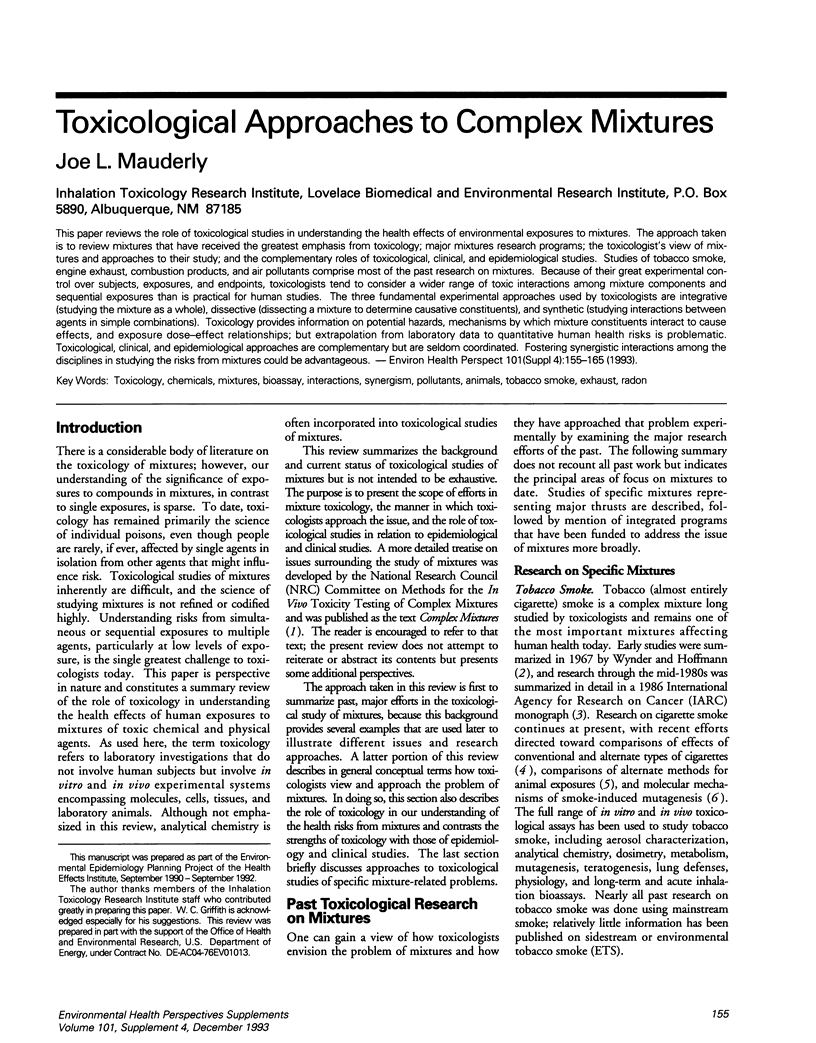
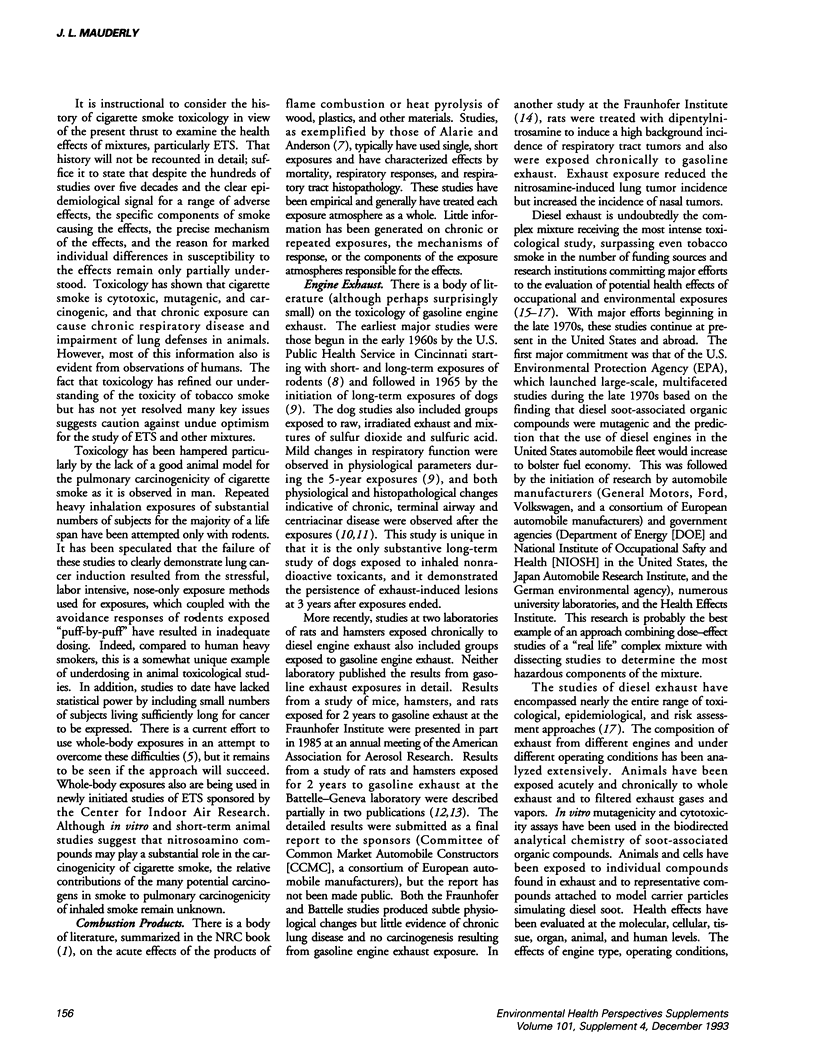
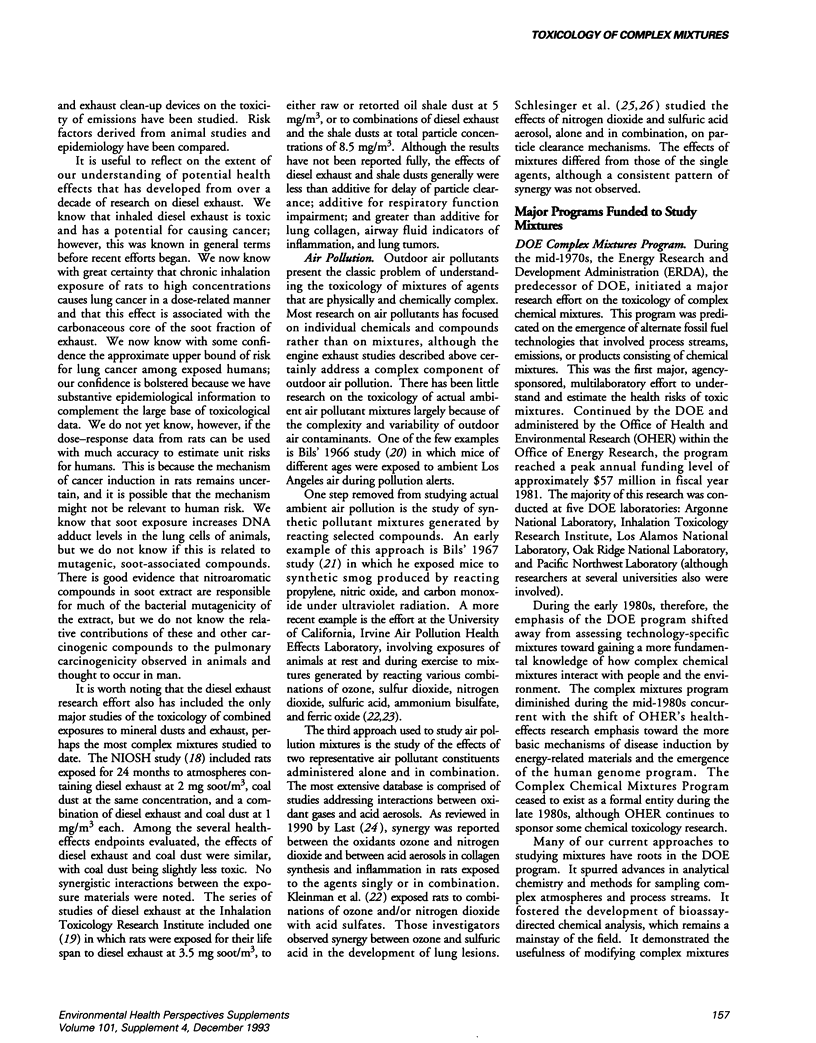
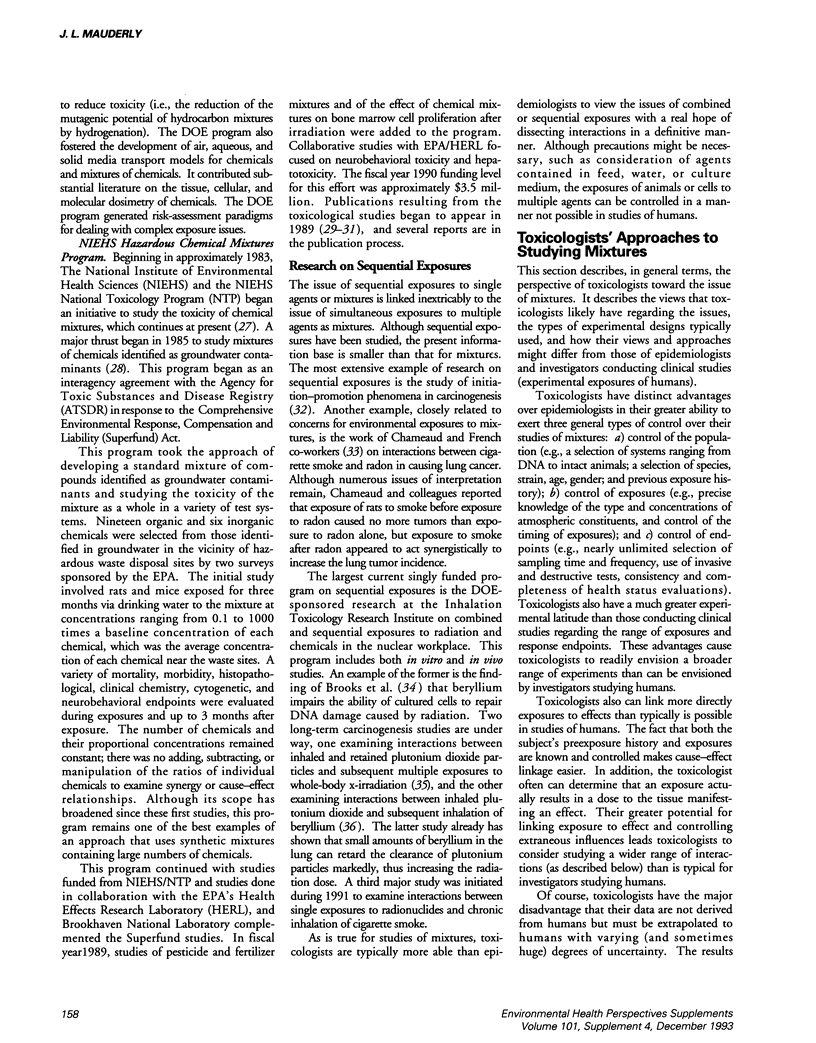
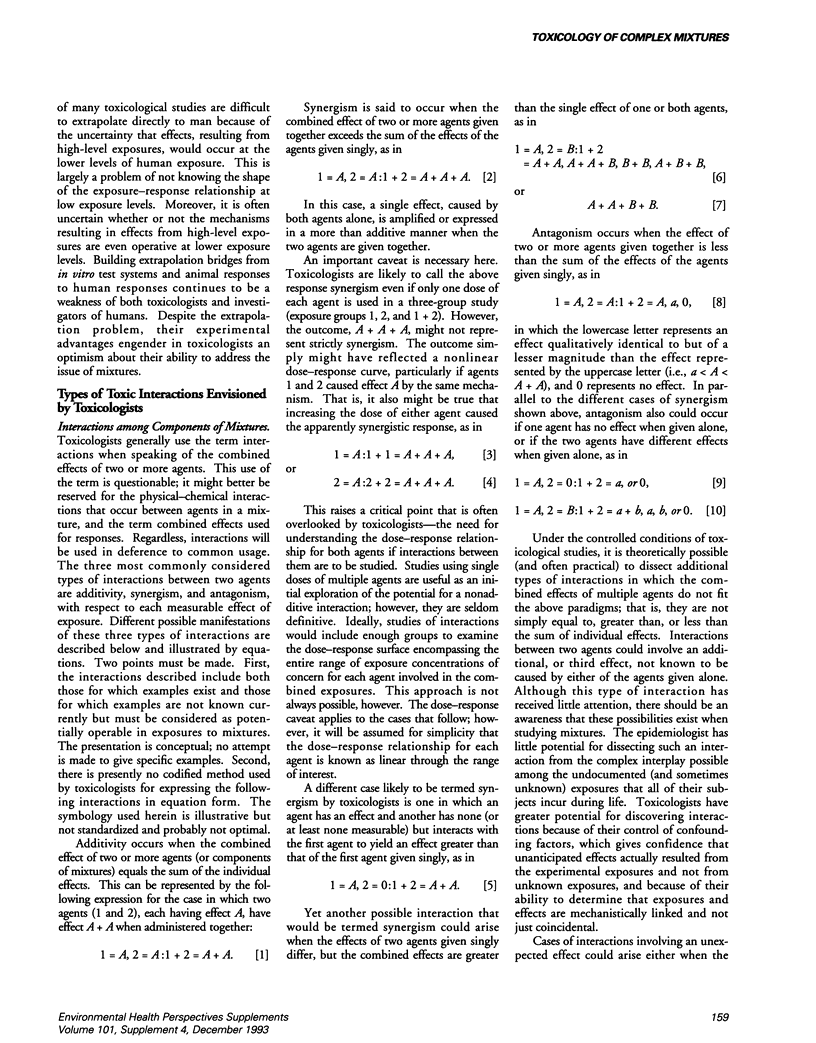
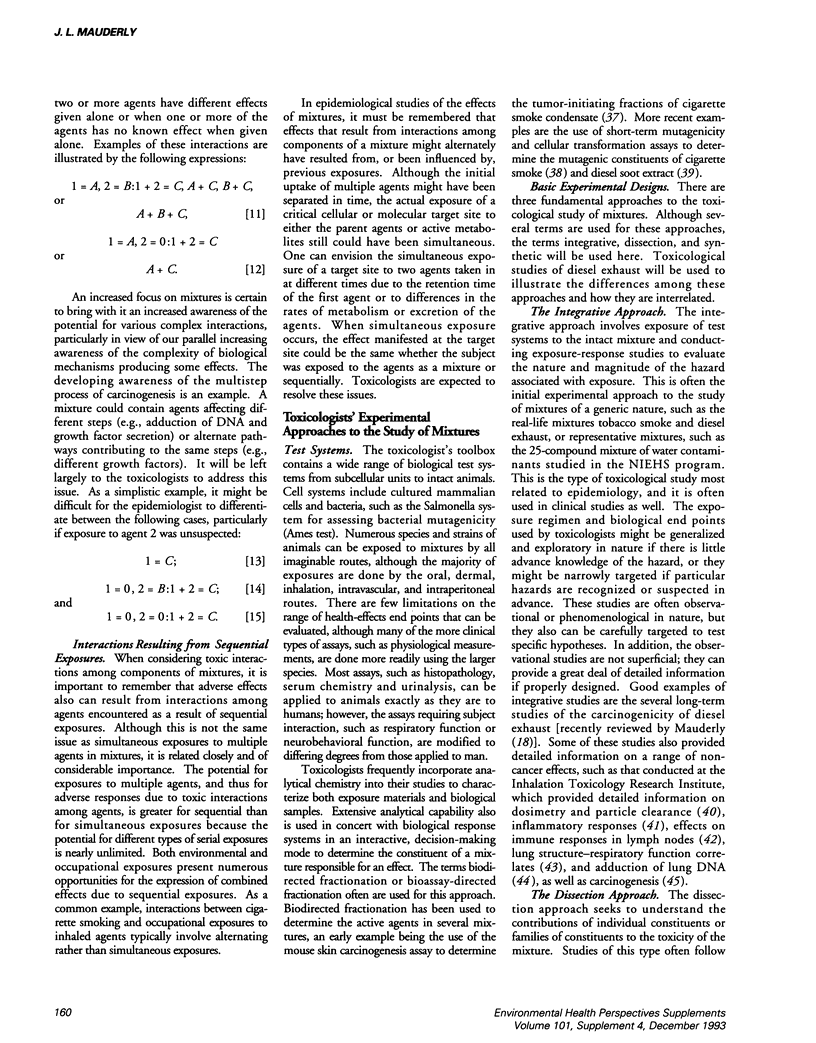
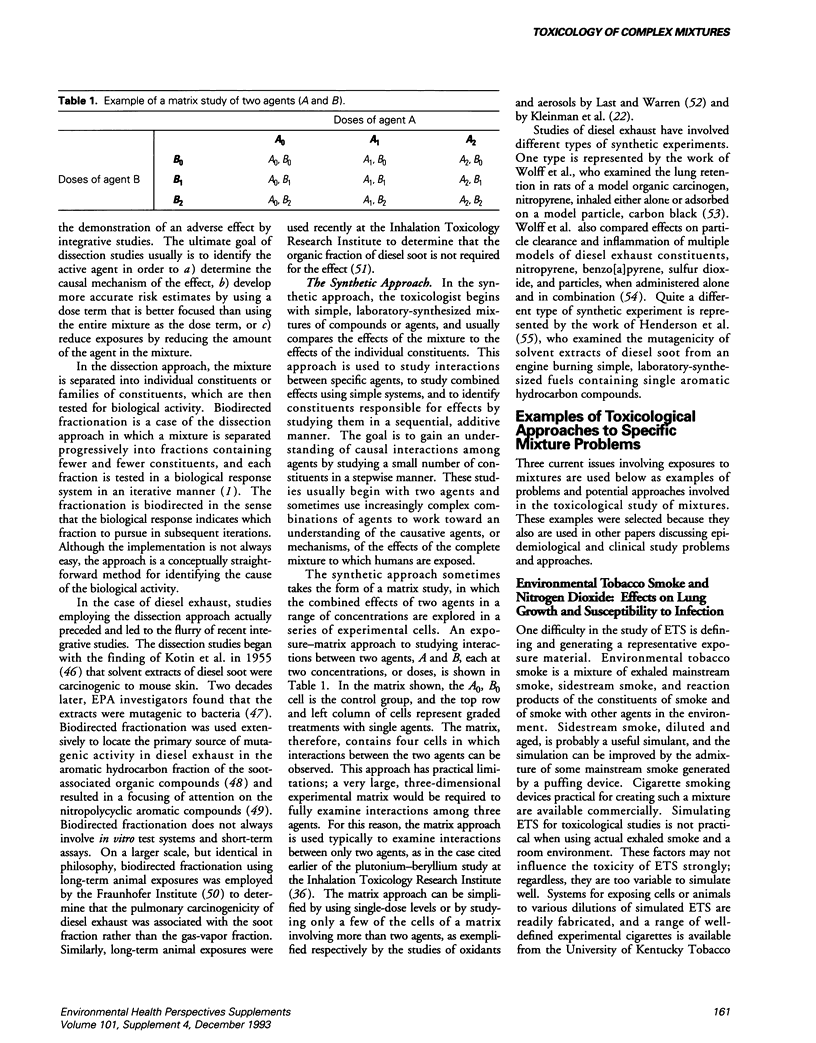
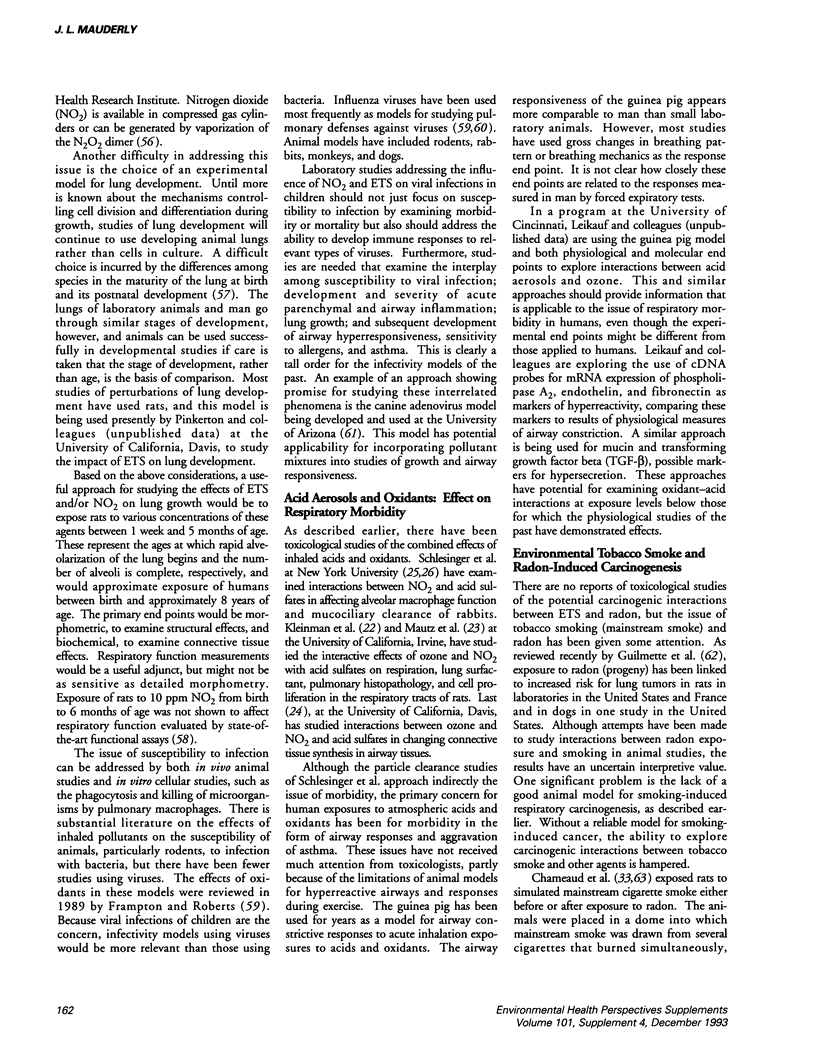
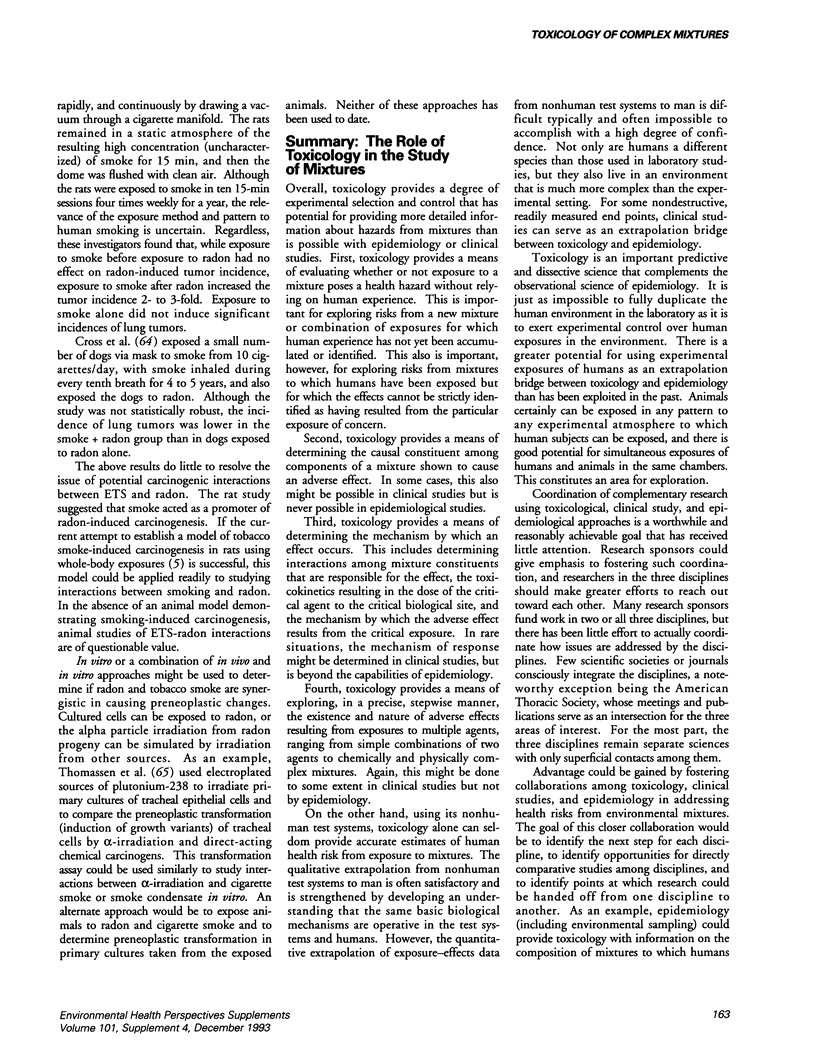
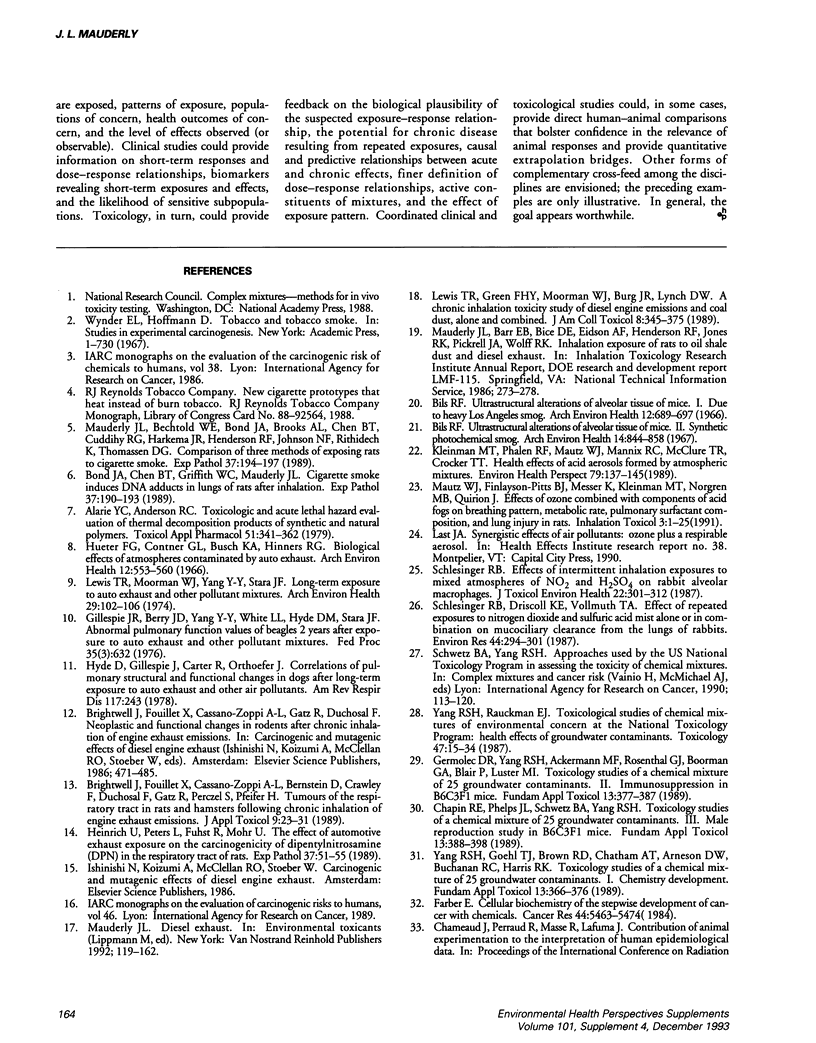
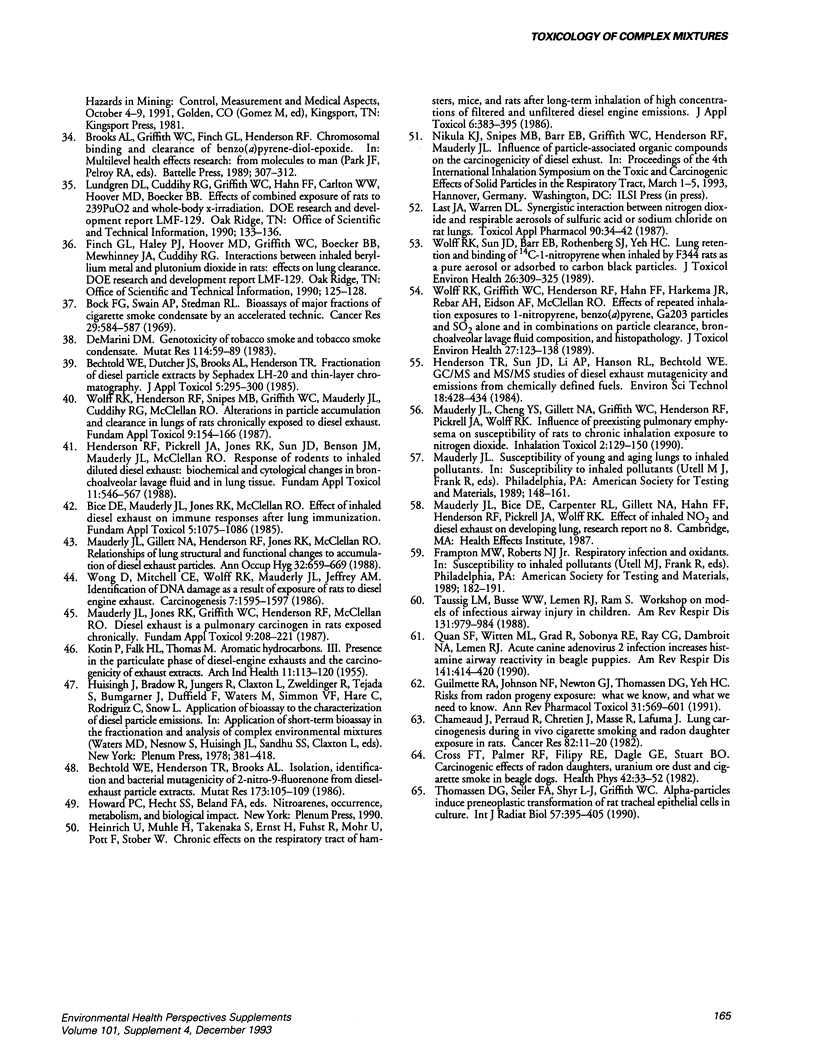
Selected References
These references are in PubMed. This may not be the complete list of references from this article.
- Alarie Y. C., Anderson R. C. Toxicologic and acute lethal hazard evaluation of thermal decomposition products of synthetic and natural polymers. Toxicol Appl Pharmacol. 1979 Nov;51(2):341–362. doi: 10.1016/0041-008x(79)90476-9. [DOI] [PubMed] [Google Scholar]
- Bechtold W. E., Dutcher J. S., Brooks A. L., Henderson T. R. Fractionation of diesel particle extracts by sephadex LH-20 and thin-layer chromatography. J Appl Toxicol. 1985 Oct;5(5):295–300. doi: 10.1002/jat.2550050507. [DOI] [PubMed] [Google Scholar]
- Bechtold W. E., Henderson T. R., Brooks A. L. Isolation, identification and bacterial mutagenicity of 2-nitro-9-fluorenone from diesel-exhaust particle extracts. Mutat Res. 1986 Feb;173(2):105–109. doi: 10.1016/0165-7992(86)90085-0. [DOI] [PubMed] [Google Scholar]
- Bice D. E., Mauderly J. L., Jones R. K., McClellan R. O. Effects of inhaled diesel exhaust on immune responses after lung immunization. Fundam Appl Toxicol. 1985 Dec;5(6 Pt 1):1075–1086. doi: 10.1016/0272-0590(85)90143-5. [DOI] [PubMed] [Google Scholar]
- Bils R. F., Romanovsky J. C. Ultrastructural alterations of alveolar tissue of mice. II. Synthetic photochemical smog. Arch Environ Health. 1967 Jun;14(6):844–858. doi: 10.1080/00039896.1967.10664851. [DOI] [PubMed] [Google Scholar]
- Bils R. F. Ultrastructural alterations of alveolar tissue of mice. I. Due to heavy Los Angeles smog. Arch Environ Health. 1966 Jun;12(6):689–697. doi: 10.1080/00039896.1966.10664466. [DOI] [PubMed] [Google Scholar]
- Bock F. G., Swain A. P., Stedman R. L. Bioassay of major fractions of cigarette smoke condensate by an accelerated technic. Cancer Res. 1969 Mar;29(3):584–587. [PubMed] [Google Scholar]
- Bond J. A., Chen B. T., Griffith W. C., Mauderly J. L. Cigarette smoke induces DNA adducts in lungs of rats after inhalation. Exp Pathol. 1989;37(1-4):190–193. doi: 10.1016/s0232-1513(89)80046-5. [DOI] [PubMed] [Google Scholar]
- Brightwell J., Fouillet X., Cassano-Zoppi A. L., Bernstein D., Crawley F., Duchosal F., Gatz R., Perczel S., Pfeifer H. Tumours of the respiratory tract in rats and hamsters following chronic inhalation of engine exhaust emissions. J Appl Toxicol. 1989 Feb;9(1):23–31. doi: 10.1002/jat.2550090106. [DOI] [PubMed] [Google Scholar]
- Chameaud J., Perraud R., Chrétien J., Masse R., Lafuma J. Lung carcinogenesis during in vivo cigarette smoking and radon daughter exposure in rats. Recent Results Cancer Res. 1982;82:11–20. doi: 10.1007/978-3-642-81768-7_2. [DOI] [PubMed] [Google Scholar]
- Chapin R. E., Phelps J. L., Schwetz B. A., Yang R. S. Toxicology studies of a chemical mixture of 25 groundwater contaminants. III. Male reproduction study in B6C3F1 mice. Fundam Appl Toxicol. 1989 Oct;13(3):388–398. doi: 10.1016/0272-0590(89)90276-5. [DOI] [PubMed] [Google Scholar]
- Cross F. T., Palmer R. F., Filipy R. E., Dagle G. E., Stuart B. O. Carcinogenic effects of radon daughters, uranium ore dust and cigarette smoke in beagle dogs. Health Phys. 1982 Jan;42(1):33–52. doi: 10.1097/00004032-198201000-00004. [DOI] [PubMed] [Google Scholar]
- DeMarini D. M. Genotoxicity of tobacco smoke and tobacco smoke condensate. Mutat Res. 1983 Jan;114(1):59–89. doi: 10.1016/0165-1110(83)90019-2. [DOI] [PubMed] [Google Scholar]
- Farber E. Cellular biochemistry of the stepwise development of cancer with chemicals: G. H. A. Clowes memorial lecture. Cancer Res. 1984 Dec;44(12 Pt 1):5463–5474. [PubMed] [Google Scholar]
- Germolec D. R., Yang R. S., Ackermann M. F., Rosenthal G. J., Boorman G. A., Blair P., Luster M. I. Toxicology studies of a chemical mixture of 25 groundwater contaminants. II. Immunosuppression in B6C3F1 mice. Fundam Appl Toxicol. 1989 Oct;13(3):377–387. doi: 10.1016/0272-0590(89)90275-3. [DOI] [PubMed] [Google Scholar]
- Guilmette R. A., Johnson N. F., Newton G. J., Thomassen D. G., Yeh H. C. Risks from radon progeny exposure: what we know, and what we need to know. Annu Rev Pharmacol Toxicol. 1991;31:569–601. doi: 10.1146/annurev.pa.31.040191.003033. [DOI] [PubMed] [Google Scholar]
- Heinrich U., Muhle H., Takenaka S., Ernst H., Fuhst R., Mohr U., Pott F., Stöber W. Chronic effects on the respiratory tract of hamsters, mice and rats after long-term inhalation of high concentrations of filtered and unfiltered diesel engine emissions. J Appl Toxicol. 1986 Dec;6(6):383–395. doi: 10.1002/jat.2550060602. [DOI] [PubMed] [Google Scholar]
- Henderson R. F., Pickrell J. A., Jones R. K., Sun J. D., Benson J. M., Mauderly J. L., McClellan R. O. Response of rodents to inhaled diluted diesel exhaust: biochemical and cytological changes in bronchoalveolar lavage fluid and in lung tissue. Fundam Appl Toxicol. 1988 Oct;11(3):546–567. doi: 10.1016/0272-0590(88)90119-4. [DOI] [PubMed] [Google Scholar]
- Hueter F. G., Contner G. L., Busch K. A., Hinners R. G. Biological effects of atmospheres contaminated by auto exhaust. Arch Environ Health. 1966 May;12(5):553–560. doi: 10.1080/00039896.1966.10664432. [DOI] [PubMed] [Google Scholar]
- KOTIN P., FALK H. L., THOMAS M. Aromatic hydrocarbons. III. Presence in the particulate phase of diesel-engine exhausts and the carcinogenicity of exhaust extracts. AMA Arch Ind Health. 1955 Feb;11(2):113–120. [PubMed] [Google Scholar]
- Kleinman M. T., Phalen R. F., Mautz W. J., Mannix R. C., McClure T. R., Crocker T. T. Health effects of acid aerosols formed by atmospheric mixtures. Environ Health Perspect. 1989 Feb;79:137–145. doi: 10.1289/ehp.8979137. [DOI] [PMC free article] [PubMed] [Google Scholar]
- Last J. A., Warren D. L. Synergistic interaction between nitrogen dioxide and respirable aerosols of sulfuric acid or sodium chloride on rat lungs. Toxicol Appl Pharmacol. 1987 Aug;90(1):34–42. doi: 10.1016/0041-008x(87)90303-6. [DOI] [PubMed] [Google Scholar]
- Lewis T. R., Moorman W. J., Yang Y. Y., Stara J. F. Long-term exposure to auto exhaust and other pollutant mixtures: effects on pulmonary function in the beagle. Arch Environ Health. 1974 Aug;29(2):102–106. doi: 10.1080/00039896.1974.10666541. [DOI] [PubMed] [Google Scholar]
- Mauderly J. L., Bechtold W. E., Bond J. A., Brooks A. L., Chen B. T., Cuddihy R. G., Harkema J. R., Henderson R. F., Johnson N. F., Rithidech K. Comparison of 3 methods of exposing rats to cigarette smoke. Exp Pathol. 1989;37(1-4):194–197. [PubMed] [Google Scholar]
- Mauderly J. L., Jones R. K., Griffith W. C., Henderson R. F., McClellan R. O. Diesel exhaust is a pulmonary carcinogen in rats exposed chronically by inhalation. Fundam Appl Toxicol. 1987 Aug;9(2):208–221. doi: 10.1016/0272-0590(87)90044-3. [DOI] [PubMed] [Google Scholar]
- Quan S. F., Witten M. L., Grad R., Sobonya R. E., Ray C. G., Dambro N. N., Lemen R. J. Acute canine adenovirus 2 infection increases histamine airway reactivity in beagle puppies. Am Rev Respir Dis. 1990 Feb;141(2):414–420. doi: 10.1164/ajrccm/141.2.414. [DOI] [PubMed] [Google Scholar]
- Schlesinger R. B., Driscoll K. E., Vollmuth T. A. Effect of repeated exposures to nitrogen dioxide and sulfuric acid mist alone or in combination on mucociliary clearance from the lungs of rabbits. Environ Res. 1987 Dec;44(2):294–301. doi: 10.1016/s0013-9351(87)80238-4. [DOI] [PubMed] [Google Scholar]
- Schlesinger R. B. Effects of intermittent inhalation exposures to mixed atmospheres of NO2 and H2SO4 on rabbit alveolar macrophages. J Toxicol Environ Health. 1987;22(3):301–312. doi: 10.1080/15287398709531073. [DOI] [PubMed] [Google Scholar]
- Taussig L. M., Busse W. W., Lemen R. J., Ram J. S. NHLBI workshop summary. Models of infectious airway injury in children. Am Rev Respir Dis. 1988 Apr;137(4):979–984. doi: 10.1164/ajrccm/137.4.979. [DOI] [PubMed] [Google Scholar]
- Thomassen D. G., Seiler F. A., Shyr L. J., Griffith W. C. Alpha-particles induce preneoplastic transformation of rat tracheal epithelial cells in culture. Int J Radiat Biol. 1990 Feb;57(2):395–405. doi: 10.1080/09553009014552491. [DOI] [PubMed] [Google Scholar]
- Wolff R. K., Griffith W. C., Henderson R. F., Hahn F. F., Harkema J. R., Rebar A. H., Eidson A. F., McClellan R. O. Effects of repeated inhalation exposures to 1-nitropyrene, benzo[a]pyrene, Ga2O3 particles, and SO2 alone and in combinations on particle clearance, bronchoalveolar lavage fluid composition, and histopathology. J Toxicol Environ Health. 1989;27(1):123–138. doi: 10.1080/15287398909531283. [DOI] [PubMed] [Google Scholar]
- Wolff R. K., Henderson R. F., Snipes M. B., Griffith W. C., Mauderly J. L., Cuddihy R. G., McClellan R. O. Alterations in particle accumulation and clearance in lungs of rats chronically exposed to diesel exhaust. Fundam Appl Toxicol. 1987 Jul;9(1):154–166. doi: 10.1016/0272-0590(87)90162-x. [DOI] [PubMed] [Google Scholar]
- Wolff R. K., Sun J. D., Barr E. B., Rothenberg S. J., Yeh H. C. Lung retention and binding of [14C]-1-nitropyrene when inhaled by F344 rats as a pure aerosol or adsorbed to carbon black particles. J Toxicol Environ Health. 1989;26(3):309–325. doi: 10.1080/15287398909531256. [DOI] [PubMed] [Google Scholar]
- Wong D., Mitchell C. E., Wolff R. K., Mauderly J. L., Jeffrey A. M. Identification of DNA damage as a result of exposure of rats to diesel engine exhaust. Carcinogenesis. 1986 Sep;7(9):1595–1597. doi: 10.1093/carcin/7.9.1595. [DOI] [PubMed] [Google Scholar]
- Yang R. S., Goehl T. J., Brown R. D., Chatham A. T., Arneson D. W., Buchanan R. C., Harris R. K. Toxicology studies of a chemical mixture of 25 groundwater contaminants. I. Chemistry development. Fundam Appl Toxicol. 1989 Oct;13(3):366–376. doi: 10.1016/0272-0590(89)90274-1. [DOI] [PubMed] [Google Scholar]
- Yang R. S., Rauckman E. J. Toxicological studies of chemical mixtures of environmental concern at the National Toxicology Program: health effects of groundwater contaminants. Toxicology. 1987 Dec 1;47(1-2):15–34. doi: 10.1016/0300-483x(87)90158-2. [DOI] [PubMed] [Google Scholar]


